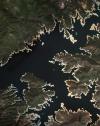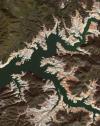Before-and-After
CU Boulder’s Grand Challenge: Our Space. Our Future. tackles global challenges including drought, illustrated above and here in before-and-after images of drought-diminished Lake Shasta.
High-resolution imagery provided by CU Boulder partner DigitalGlobe.
Catching Fire
Earth Lab and DigitalGlobe Partnership Sparks CU Boulder’s Grand Challenge
Principal
Jennifer Balch
Collaboration/Support
CU Boulder's Grand Challenge; Earth Lab; DigitalGlobe
More than a thousand satellites orbit Earth, including remote sensing satellites collecting vast amounts of data about global temperature, forest health, ocean circulation, sea ice and erosion. Scientists increasingly have access to more information than they can digest. Now, wildfire expert Jennifer Balch, her Earth Lab team, and new partner DigitalGlobe are tapping into that information to transform our understanding of wildfires.
Earth Lab, part of CU Boulder’s Grand Challenge: Our Space. Our Future. is an earth science data synthesis center designed to organize, interpret and integrate the observational data Earth receives every day. Earth Lab translates the university’s expertise in earth, space and social sciences into real-world solutions to global problems.
One such problem is exploring how people influence fire, particularly in transitional areas of wildland and human development. The stakes are sky-high: U.S. federal agencies alone spend $2 to $3 billion annually to fight fires. As more people migrate into wildland-urban interface areas around the world and the warmer, drier climate increases the frequency and severity of wildfires, the human and financial toll will continue to skyrocket.
Earth Lab already collaborates with federal agencies such as NASA labs collecting data about the water cycle, gravitational pull and cloud and snow cover. Earth Lab also uses data related to forestry, agriculture and geology from the U.S. Geological Survey’s Landsat satellite. Now, Earth Lab and DigitalGlobe, a world leader in satellite imagery, are introducing vastly enhanced imagery and analytics into the mix, including the global wildfire picture.
DigitalGlobe, located in nearby Westminster, Colorado, is providing CU Boulder access to its extensive collection of high-resolution images and related tools in exchange for access to the university’s top-ranked science faculty and research staff.
“The partnership is ‘next level’,” says Emily CoBabe-Ammann, director of Strategic Projects and strategic lead for the Grand Challenge. “It’s exciting because it accelerates Earth Lab and the Grand Challenge. It’s transformational because it encourages collaborators like government agencies and other university partners to bring their data to the party and develop new products to solve global problems.”
According to Earth Lab’s director, Jennifer Balch, “It’s a unique and exciting time for fire-science. We now have high-resolution imagery and information from multiple sources, and the tools to integrate them to ask questions we’ve never been able to consider before, and at a scale previously not possible.”
“What tools can we create for firefighters and homeowners who need real-time fire information? How can we inform insurers, developers and legislators who can shift infrastructure and policy planning to protect individuals, communities and our environment from the consequences of unenlightened practices and policies?”
Earth Lab projects studying permafrost, erosion, forest loss, data harmonization and decision-making will eventually leverage DigitalGlobe resources. For now, Earth Lab is focused on integrating DigitalGlobe assets to help identify changing fire patterns and social vulnerabilities at a large scale.
One cutting-edge project, led by undergraduate Mollie Buckland, is even exploring the relationship between the speed and size of wildfires and the volume of social media activity concerned with those fires.
And like a social media topic “going viral,” there’s no telling how far such a transformational collaboration can take fire-science.



